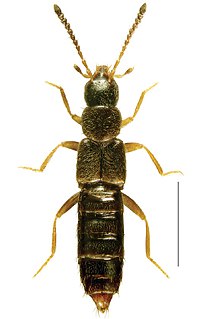
Elmidae, commonly known as riffle beetles, is a family of beetles in the superfamily Byrrhoidea described by John Curtis in 1830. Both adults and larvae are usually aquatic, living under rocks in fast-flowing shallow areas of streams, such as riffles, feeding on algae and biofilms. There are more than 150 genera and 1,500 described species in Elmidae. The oldest record of the group is Cretohypsilara from the Cenomanian aged Burmese amber.
Paromalini is a tribe of clown beetles in the family Histeridae. There are at least 270 described species in Paromalini.

Dendrophilinae is a subfamily of clown beetles in the family Histeridae. There are more than 30 genera and 490 described species in Dendrophilinae.
Xestipyge is a genus of clown beetles in the family Histeridae. There are at least 9 described species in Xestipyge.
Atholus americanus is a species of clown beetle in the family Histeridae. It is found in North America, ranging from the eastern foothills of the Rocky Mountains to central Quebec, with its southern extents poorly known. It ranges in size from 2.7 to 4.2mm. This species is distinct from other members of Atholus because of its united 5th dorsal and sutural striations and the lack of any subhumeral striations.
Sceptobius is a genus of rove beetles in the family Staphylinidae. There are at least three described species in Sceptobius.

Halobrecta is a genus of rove beetles in the family Staphylinidae. There are about six described species in Halobrecta.
Acritus acaroides is a species of clown beetle in the family Histeridae and tribe Acritini. It ranges in size from 0.9-1.1mm, very rarely reaching 2mm. It is found in North America, roughly from eastern Texas to South Carolina.
Cyrtusa is a genus of round fungus beetles in the family Leiodidae. There are at least two described species in Cyrtusa.
Peploglyptus is a genus of clown beetles in the family Histeridae. There are at least three described species in Peploglyptus.
Eremosaprinus unguiculatus is a species of clown beetle in the family Histeridae. It is found in North America.
Eremosaprinus minimus is a species of clown beetle in the family Histeridae. It is found in North America.
Ipelates is a genus of primitive carrion beetles in the family Agyrtidae. There are at least four described species in Ipelates.
Atheta ventricosa is a species of rove beetle in the family Staphylinidae. It is found in North America.
Conoplectus is a genus of ant-loving beetles in the family Staphylinidae. There are about five described species in Conoplectus.
Renclasea is a genus of clown beetles in the family Histeridae. There are about six described species in Renclasea.
Platycholeus is a genus of small carrion beetles in the family Leiodidae. There are at least two described species in Platycholeus.
Eurylister carolinus is a species of clown beetle in the family Histeridae. It is found in North America.
Ochthebius marinus, the marine moss beetle, is a species of minute moss beetle in the family Hydraenidae. It is found in Europe & Northern Asia, North America, and Southern Asia.
Triarthron is a genus of round fungus beetles in the family Leiodidae. There are at least two described species in Triarthron.


